Nursing Case Study on Type 2 Diabetes
VerifiedAdded on 2023/01/07
|8
|2561
|71
AI Summary
This nursing case study explores the pathophysiology, complications, and treatment of type 2 diabetes. It discusses the medication and blood test results of the patient, Emily. The study also analyzes the implications of the renal function test. Read more to gain insights into managing type 2 diabetes.
Contribute Materials
Your contribution can guide someone’s learning journey. Share your
documents today.
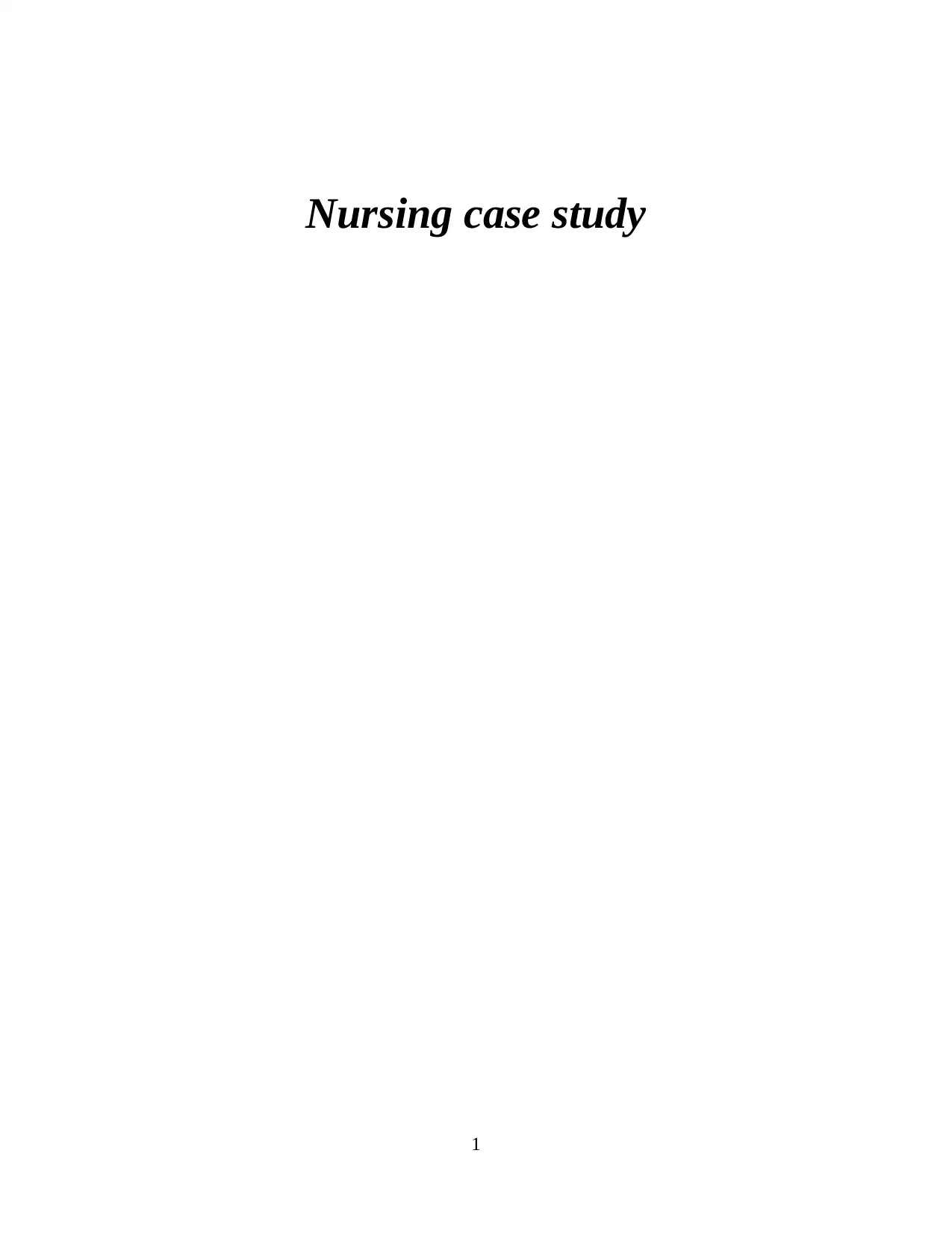
Nursing case study
1
1
Secure Best Marks with AI Grader
Need help grading? Try our AI Grader for instant feedback on your assignments.
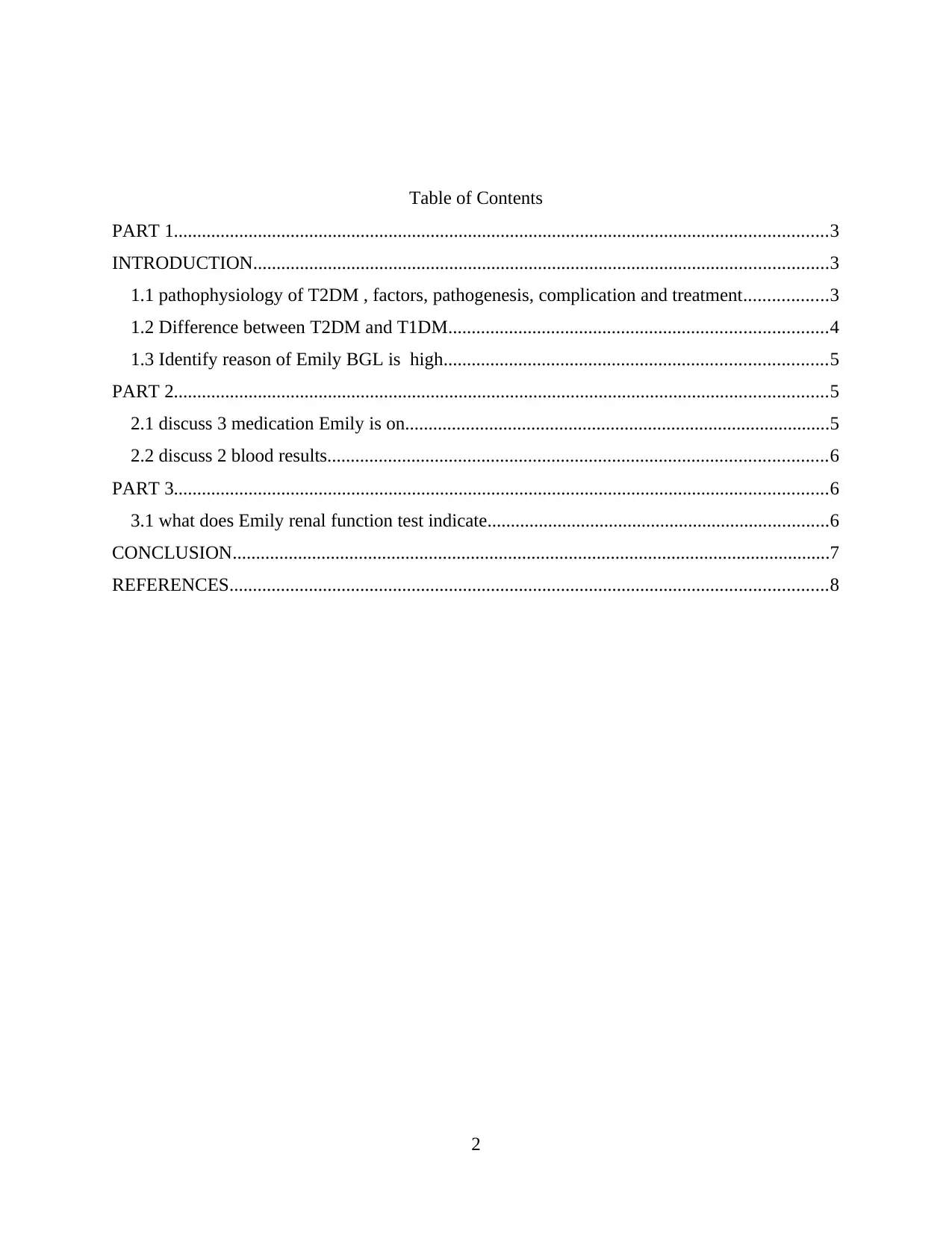
Table of Contents
PART 1............................................................................................................................................3
INTRODUCTION...........................................................................................................................3
1.1 pathophysiology of T2DM , factors, pathogenesis, complication and treatment..................3
1.2 Difference between T2DM and T1DM.................................................................................4
1.3 Identify reason of Emily BGL is high..................................................................................5
PART 2............................................................................................................................................5
2.1 discuss 3 medication Emily is on...........................................................................................5
2.2 discuss 2 blood results...........................................................................................................6
PART 3............................................................................................................................................6
3.1 what does Emily renal function test indicate.........................................................................6
CONCLUSION................................................................................................................................7
REFERENCES................................................................................................................................8
2
PART 1............................................................................................................................................3
INTRODUCTION...........................................................................................................................3
1.1 pathophysiology of T2DM , factors, pathogenesis, complication and treatment..................3
1.2 Difference between T2DM and T1DM.................................................................................4
1.3 Identify reason of Emily BGL is high..................................................................................5
PART 2............................................................................................................................................5
2.1 discuss 3 medication Emily is on...........................................................................................5
2.2 discuss 2 blood results...........................................................................................................6
PART 3............................................................................................................................................6
3.1 what does Emily renal function test indicate.........................................................................6
CONCLUSION................................................................................................................................7
REFERENCES................................................................................................................................8
2
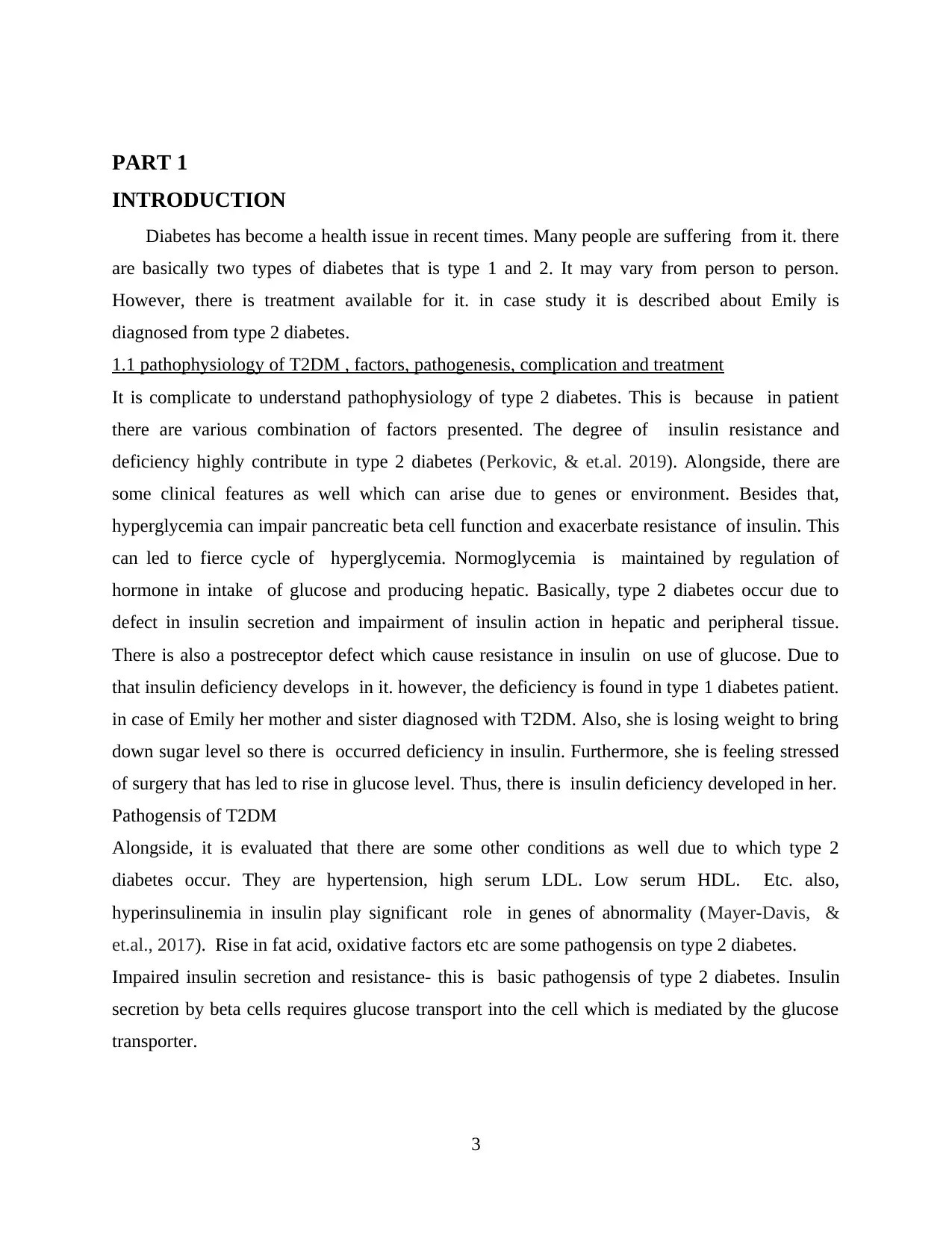
PART 1
INTRODUCTION
Diabetes has become a health issue in recent times. Many people are suffering from it. there
are basically two types of diabetes that is type 1 and 2. It may vary from person to person.
However, there is treatment available for it. in case study it is described about Emily is
diagnosed from type 2 diabetes.
1.1 pathophysiology of T2DM , factors, pathogenesis, complication and treatment
It is complicate to understand pathophysiology of type 2 diabetes. This is because in patient
there are various combination of factors presented. The degree of insulin resistance and
deficiency highly contribute in type 2 diabetes (Perkovic, & et.al. 2019). Alongside, there are
some clinical features as well which can arise due to genes or environment. Besides that,
hyperglycemia can impair pancreatic beta cell function and exacerbate resistance of insulin. This
can led to fierce cycle of hyperglycemia. Normoglycemia is maintained by regulation of
hormone in intake of glucose and producing hepatic. Basically, type 2 diabetes occur due to
defect in insulin secretion and impairment of insulin action in hepatic and peripheral tissue.
There is also a postreceptor defect which cause resistance in insulin on use of glucose. Due to
that insulin deficiency develops in it. however, the deficiency is found in type 1 diabetes patient.
in case of Emily her mother and sister diagnosed with T2DM. Also, she is losing weight to bring
down sugar level so there is occurred deficiency in insulin. Furthermore, she is feeling stressed
of surgery that has led to rise in glucose level. Thus, there is insulin deficiency developed in her.
Pathogensis of T2DM
Alongside, it is evaluated that there are some other conditions as well due to which type 2
diabetes occur. They are hypertension, high serum LDL. Low serum HDL. Etc. also,
hyperinsulinemia in insulin play significant role in genes of abnormality (Mayer-Davis, &
et.al., 2017). Rise in fat acid, oxidative factors etc are some pathogensis on type 2 diabetes.
Impaired insulin secretion and resistance- this is basic pathogensis of type 2 diabetes. Insulin
secretion by beta cells requires glucose transport into the cell which is mediated by the glucose
transporter.
3
INTRODUCTION
Diabetes has become a health issue in recent times. Many people are suffering from it. there
are basically two types of diabetes that is type 1 and 2. It may vary from person to person.
However, there is treatment available for it. in case study it is described about Emily is
diagnosed from type 2 diabetes.
1.1 pathophysiology of T2DM , factors, pathogenesis, complication and treatment
It is complicate to understand pathophysiology of type 2 diabetes. This is because in patient
there are various combination of factors presented. The degree of insulin resistance and
deficiency highly contribute in type 2 diabetes (Perkovic, & et.al. 2019). Alongside, there are
some clinical features as well which can arise due to genes or environment. Besides that,
hyperglycemia can impair pancreatic beta cell function and exacerbate resistance of insulin. This
can led to fierce cycle of hyperglycemia. Normoglycemia is maintained by regulation of
hormone in intake of glucose and producing hepatic. Basically, type 2 diabetes occur due to
defect in insulin secretion and impairment of insulin action in hepatic and peripheral tissue.
There is also a postreceptor defect which cause resistance in insulin on use of glucose. Due to
that insulin deficiency develops in it. however, the deficiency is found in type 1 diabetes patient.
in case of Emily her mother and sister diagnosed with T2DM. Also, she is losing weight to bring
down sugar level so there is occurred deficiency in insulin. Furthermore, she is feeling stressed
of surgery that has led to rise in glucose level. Thus, there is insulin deficiency developed in her.
Pathogensis of T2DM
Alongside, it is evaluated that there are some other conditions as well due to which type 2
diabetes occur. They are hypertension, high serum LDL. Low serum HDL. Etc. also,
hyperinsulinemia in insulin play significant role in genes of abnormality (Mayer-Davis, &
et.al., 2017). Rise in fat acid, oxidative factors etc are some pathogensis on type 2 diabetes.
Impaired insulin secretion and resistance- this is basic pathogensis of type 2 diabetes. Insulin
secretion by beta cells requires glucose transport into the cell which is mediated by the glucose
transporter.
3
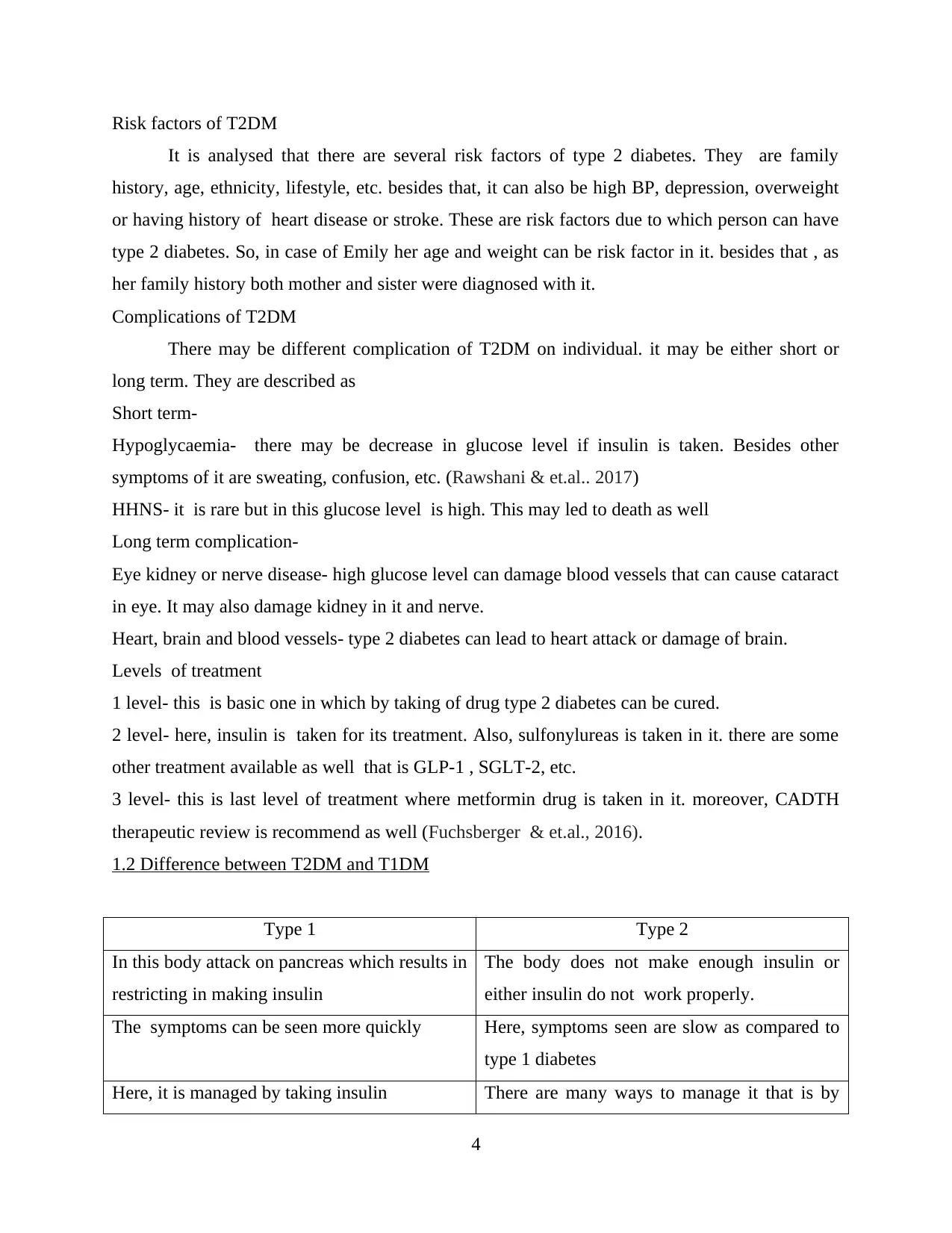
Risk factors of T2DM
It is analysed that there are several risk factors of type 2 diabetes. They are family
history, age, ethnicity, lifestyle, etc. besides that, it can also be high BP, depression, overweight
or having history of heart disease or stroke. These are risk factors due to which person can have
type 2 diabetes. So, in case of Emily her age and weight can be risk factor in it. besides that , as
her family history both mother and sister were diagnosed with it.
Complications of T2DM
There may be different complication of T2DM on individual. it may be either short or
long term. They are described as
Short term-
Hypoglycaemia- there may be decrease in glucose level if insulin is taken. Besides other
symptoms of it are sweating, confusion, etc. (Rawshani & et.al.. 2017)
HHNS- it is rare but in this glucose level is high. This may led to death as well
Long term complication-
Eye kidney or nerve disease- high glucose level can damage blood vessels that can cause cataract
in eye. It may also damage kidney in it and nerve.
Heart, brain and blood vessels- type 2 diabetes can lead to heart attack or damage of brain.
Levels of treatment
1 level- this is basic one in which by taking of drug type 2 diabetes can be cured.
2 level- here, insulin is taken for its treatment. Also, sulfonylureas is taken in it. there are some
other treatment available as well that is GLP-1 , SGLT-2, etc.
3 level- this is last level of treatment where metformin drug is taken in it. moreover, CADTH
therapeutic review is recommend as well (Fuchsberger & et.al., 2016).
1.2 Difference between T2DM and T1DM
Type 1 Type 2
In this body attack on pancreas which results in
restricting in making insulin
The body does not make enough insulin or
either insulin do not work properly.
The symptoms can be seen more quickly Here, symptoms seen are slow as compared to
type 1 diabetes
Here, it is managed by taking insulin There are many ways to manage it that is by
4
It is analysed that there are several risk factors of type 2 diabetes. They are family
history, age, ethnicity, lifestyle, etc. besides that, it can also be high BP, depression, overweight
or having history of heart disease or stroke. These are risk factors due to which person can have
type 2 diabetes. So, in case of Emily her age and weight can be risk factor in it. besides that , as
her family history both mother and sister were diagnosed with it.
Complications of T2DM
There may be different complication of T2DM on individual. it may be either short or
long term. They are described as
Short term-
Hypoglycaemia- there may be decrease in glucose level if insulin is taken. Besides other
symptoms of it are sweating, confusion, etc. (Rawshani & et.al.. 2017)
HHNS- it is rare but in this glucose level is high. This may led to death as well
Long term complication-
Eye kidney or nerve disease- high glucose level can damage blood vessels that can cause cataract
in eye. It may also damage kidney in it and nerve.
Heart, brain and blood vessels- type 2 diabetes can lead to heart attack or damage of brain.
Levels of treatment
1 level- this is basic one in which by taking of drug type 2 diabetes can be cured.
2 level- here, insulin is taken for its treatment. Also, sulfonylureas is taken in it. there are some
other treatment available as well that is GLP-1 , SGLT-2, etc.
3 level- this is last level of treatment where metformin drug is taken in it. moreover, CADTH
therapeutic review is recommend as well (Fuchsberger & et.al., 2016).
1.2 Difference between T2DM and T1DM
Type 1 Type 2
In this body attack on pancreas which results in
restricting in making insulin
The body does not make enough insulin or
either insulin do not work properly.
The symptoms can be seen more quickly Here, symptoms seen are slow as compared to
type 1 diabetes
Here, it is managed by taking insulin There are many ways to manage it that is by
4
Secure Best Marks with AI Grader
Need help grading? Try our AI Grader for instant feedback on your assignments.
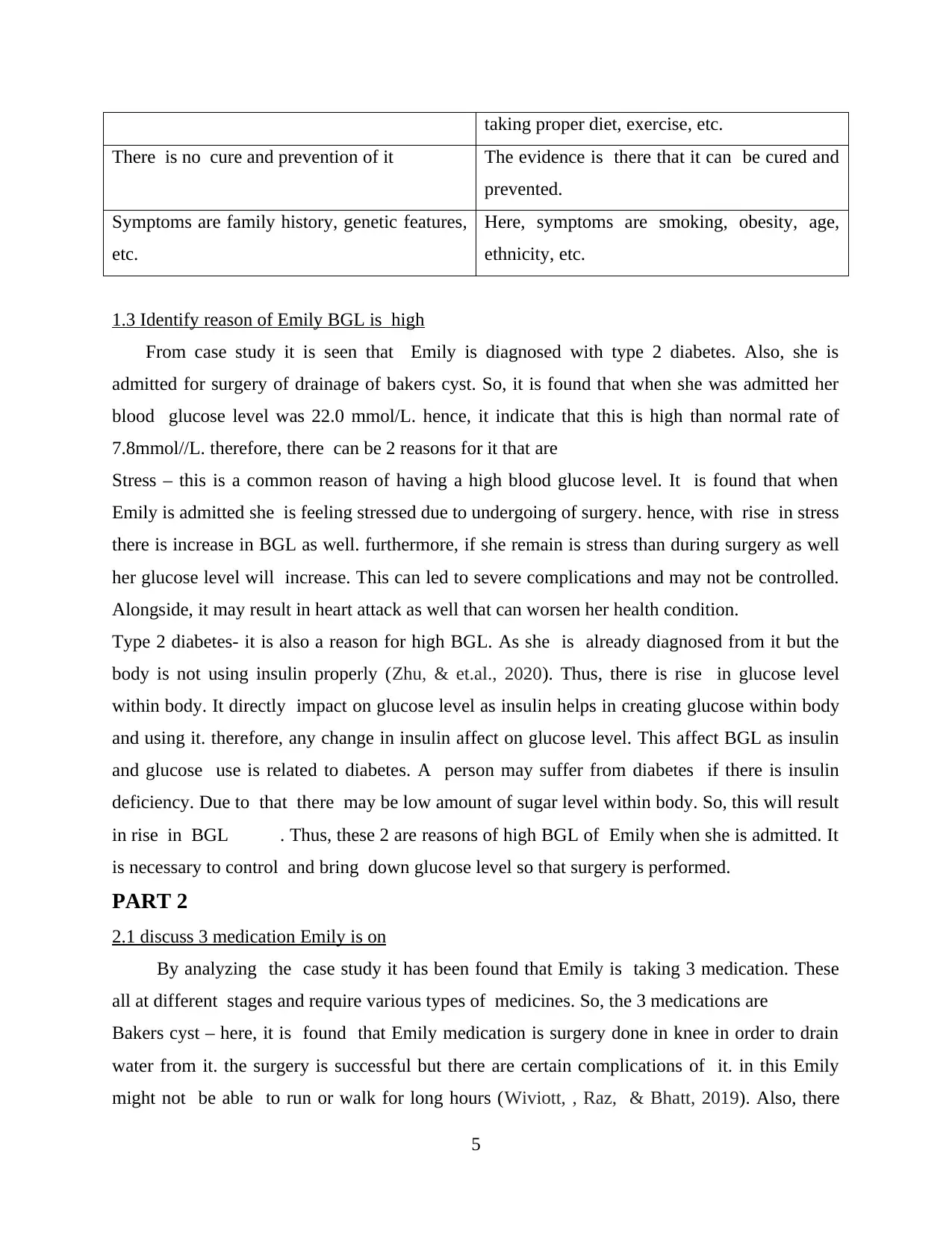
taking proper diet, exercise, etc.
There is no cure and prevention of it The evidence is there that it can be cured and
prevented.
Symptoms are family history, genetic features,
etc.
Here, symptoms are smoking, obesity, age,
ethnicity, etc.
1.3 Identify reason of Emily BGL is high
From case study it is seen that Emily is diagnosed with type 2 diabetes. Also, she is
admitted for surgery of drainage of bakers cyst. So, it is found that when she was admitted her
blood glucose level was 22.0 mmol/L. hence, it indicate that this is high than normal rate of
7.8mmol//L. therefore, there can be 2 reasons for it that are
Stress – this is a common reason of having a high blood glucose level. It is found that when
Emily is admitted she is feeling stressed due to undergoing of surgery. hence, with rise in stress
there is increase in BGL as well. furthermore, if she remain is stress than during surgery as well
her glucose level will increase. This can led to severe complications and may not be controlled.
Alongside, it may result in heart attack as well that can worsen her health condition.
Type 2 diabetes- it is also a reason for high BGL. As she is already diagnosed from it but the
body is not using insulin properly (Zhu, & et.al., 2020). Thus, there is rise in glucose level
within body. It directly impact on glucose level as insulin helps in creating glucose within body
and using it. therefore, any change in insulin affect on glucose level. This affect BGL as insulin
and glucose use is related to diabetes. A person may suffer from diabetes if there is insulin
deficiency. Due to that there may be low amount of sugar level within body. So, this will result
in rise in BGL . Thus, these 2 are reasons of high BGL of Emily when she is admitted. It
is necessary to control and bring down glucose level so that surgery is performed.
PART 2
2.1 discuss 3 medication Emily is on
By analyzing the case study it has been found that Emily is taking 3 medication. These
all at different stages and require various types of medicines. So, the 3 medications are
Bakers cyst – here, it is found that Emily medication is surgery done in knee in order to drain
water from it. the surgery is successful but there are certain complications of it. in this Emily
might not be able to run or walk for long hours (Wiviott, , Raz, & Bhatt, 2019). Also, there
5
There is no cure and prevention of it The evidence is there that it can be cured and
prevented.
Symptoms are family history, genetic features,
etc.
Here, symptoms are smoking, obesity, age,
ethnicity, etc.
1.3 Identify reason of Emily BGL is high
From case study it is seen that Emily is diagnosed with type 2 diabetes. Also, she is
admitted for surgery of drainage of bakers cyst. So, it is found that when she was admitted her
blood glucose level was 22.0 mmol/L. hence, it indicate that this is high than normal rate of
7.8mmol//L. therefore, there can be 2 reasons for it that are
Stress – this is a common reason of having a high blood glucose level. It is found that when
Emily is admitted she is feeling stressed due to undergoing of surgery. hence, with rise in stress
there is increase in BGL as well. furthermore, if she remain is stress than during surgery as well
her glucose level will increase. This can led to severe complications and may not be controlled.
Alongside, it may result in heart attack as well that can worsen her health condition.
Type 2 diabetes- it is also a reason for high BGL. As she is already diagnosed from it but the
body is not using insulin properly (Zhu, & et.al., 2020). Thus, there is rise in glucose level
within body. It directly impact on glucose level as insulin helps in creating glucose within body
and using it. therefore, any change in insulin affect on glucose level. This affect BGL as insulin
and glucose use is related to diabetes. A person may suffer from diabetes if there is insulin
deficiency. Due to that there may be low amount of sugar level within body. So, this will result
in rise in BGL . Thus, these 2 are reasons of high BGL of Emily when she is admitted. It
is necessary to control and bring down glucose level so that surgery is performed.
PART 2
2.1 discuss 3 medication Emily is on
By analyzing the case study it has been found that Emily is taking 3 medication. These
all at different stages and require various types of medicines. So, the 3 medications are
Bakers cyst – here, it is found that Emily medication is surgery done in knee in order to drain
water from it. the surgery is successful but there are certain complications of it. in this Emily
might not be able to run or walk for long hours (Wiviott, , Raz, & Bhatt, 2019). Also, there
5
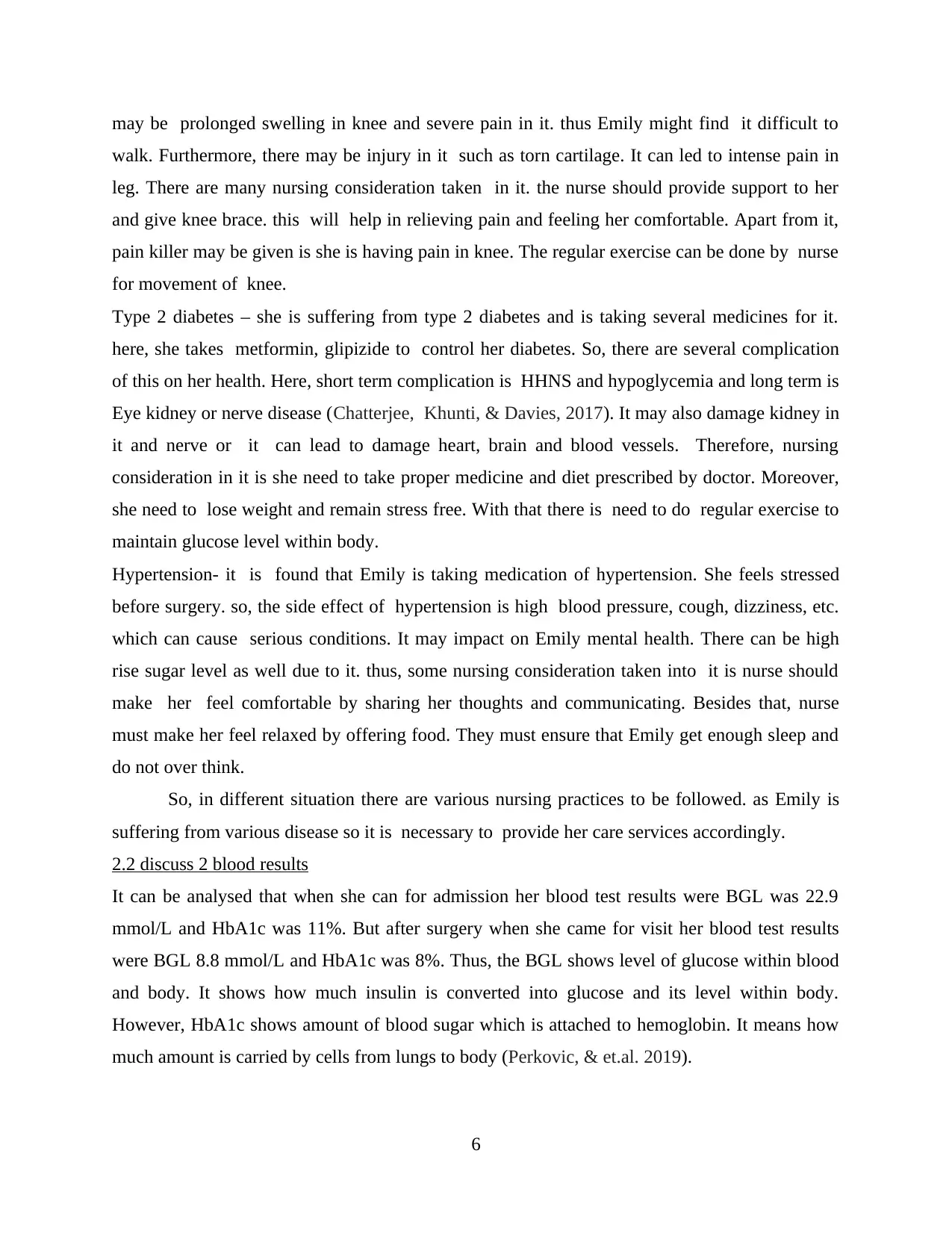
may be prolonged swelling in knee and severe pain in it. thus Emily might find it difficult to
walk. Furthermore, there may be injury in it such as torn cartilage. It can led to intense pain in
leg. There are many nursing consideration taken in it. the nurse should provide support to her
and give knee brace. this will help in relieving pain and feeling her comfortable. Apart from it,
pain killer may be given is she is having pain in knee. The regular exercise can be done by nurse
for movement of knee.
Type 2 diabetes – she is suffering from type 2 diabetes and is taking several medicines for it.
here, she takes metformin, glipizide to control her diabetes. So, there are several complication
of this on her health. Here, short term complication is HHNS and hypoglycemia and long term is
Eye kidney or nerve disease (Chatterjee, Khunti, & Davies, 2017). It may also damage kidney in
it and nerve or it can lead to damage heart, brain and blood vessels. Therefore, nursing
consideration in it is she need to take proper medicine and diet prescribed by doctor. Moreover,
she need to lose weight and remain stress free. With that there is need to do regular exercise to
maintain glucose level within body.
Hypertension- it is found that Emily is taking medication of hypertension. She feels stressed
before surgery. so, the side effect of hypertension is high blood pressure, cough, dizziness, etc.
which can cause serious conditions. It may impact on Emily mental health. There can be high
rise sugar level as well due to it. thus, some nursing consideration taken into it is nurse should
make her feel comfortable by sharing her thoughts and communicating. Besides that, nurse
must make her feel relaxed by offering food. They must ensure that Emily get enough sleep and
do not over think.
So, in different situation there are various nursing practices to be followed. as Emily is
suffering from various disease so it is necessary to provide her care services accordingly.
2.2 discuss 2 blood results
It can be analysed that when she can for admission her blood test results were BGL was 22.9
mmol/L and HbA1c was 11%. But after surgery when she came for visit her blood test results
were BGL 8.8 mmol/L and HbA1c was 8%. Thus, the BGL shows level of glucose within blood
and body. It shows how much insulin is converted into glucose and its level within body.
However, HbA1c shows amount of blood sugar which is attached to hemoglobin. It means how
much amount is carried by cells from lungs to body (Perkovic, & et.al. 2019).
6
walk. Furthermore, there may be injury in it such as torn cartilage. It can led to intense pain in
leg. There are many nursing consideration taken in it. the nurse should provide support to her
and give knee brace. this will help in relieving pain and feeling her comfortable. Apart from it,
pain killer may be given is she is having pain in knee. The regular exercise can be done by nurse
for movement of knee.
Type 2 diabetes – she is suffering from type 2 diabetes and is taking several medicines for it.
here, she takes metformin, glipizide to control her diabetes. So, there are several complication
of this on her health. Here, short term complication is HHNS and hypoglycemia and long term is
Eye kidney or nerve disease (Chatterjee, Khunti, & Davies, 2017). It may also damage kidney in
it and nerve or it can lead to damage heart, brain and blood vessels. Therefore, nursing
consideration in it is she need to take proper medicine and diet prescribed by doctor. Moreover,
she need to lose weight and remain stress free. With that there is need to do regular exercise to
maintain glucose level within body.
Hypertension- it is found that Emily is taking medication of hypertension. She feels stressed
before surgery. so, the side effect of hypertension is high blood pressure, cough, dizziness, etc.
which can cause serious conditions. It may impact on Emily mental health. There can be high
rise sugar level as well due to it. thus, some nursing consideration taken into it is nurse should
make her feel comfortable by sharing her thoughts and communicating. Besides that, nurse
must make her feel relaxed by offering food. They must ensure that Emily get enough sleep and
do not over think.
So, in different situation there are various nursing practices to be followed. as Emily is
suffering from various disease so it is necessary to provide her care services accordingly.
2.2 discuss 2 blood results
It can be analysed that when she can for admission her blood test results were BGL was 22.9
mmol/L and HbA1c was 11%. But after surgery when she came for visit her blood test results
were BGL 8.8 mmol/L and HbA1c was 8%. Thus, the BGL shows level of glucose within blood
and body. It shows how much insulin is converted into glucose and its level within body.
However, HbA1c shows amount of blood sugar which is attached to hemoglobin. It means how
much amount is carried by cells from lungs to body (Perkovic, & et.al. 2019).
6

So, these two are changed as Emily is give medicine to control diabetes. Also, she is given
metformin table to control insulin balance within body. Thus, it has led to bring down blood
sugar level in her body. Besides that since she is fasting from night so it might have resulted in
decrease in insulin within her body. However, HbA1c is also decreased with level of glucose in
body in fallen down. Therefore these might have been reason of why blood results are changed.
PART 3
3.1 what does Emily renal function test indicate
The renal function test is performed to find out kidney functioning. It shows flow of water
level and various other waste from body. Similarly, for Emily as well this test was conducted
and results shown are. Here, it state that GFR is 10ml/min which is low as compared to normal
also, serum potassium is 5.7 that is high as compare with normal. The serum urea is 17 mmol/L
which is high as well. moreover, serum creatinine is 150 umol/L that is high. Thus, these all
reading shows that Emily kidney are not working properly. It means that they are not able to
remove waste in proper way. So, it clearly means that she is suffering from kidney disease.
Therefore, it is necessary to provide her proper treatment regarding it. as she is suffering from
diabetes so doctor can prescribe her medicines to control diabetes and kidney problem. This is
best suitable treatment as there is no such major kidney problem seen in results (Mayer-Davis,
& et.al., 2017). So, Emily can get cured with it. Besides that she is suffering from hypertension
hence another treatment is healthy diet and change in lifestyle. This will enable in reducing her
tension and improving functioning of kidney. However, last treatment available is doing dialysis
in case there is kidney failure. But this treatment is not considered as she is a patient of type of
diabetes and hypertension. Therefore, it can led to critical consequences as well.
CONCLUSION
It can be concluded that Emily is diagnose with type 2 diabetes and is been admitted for
surgery of drainage of bakers cyst. Her BGL level is high during admission as she is stressed.
She is taking 3 medication but after 10 years she is suffering from some kidney disease.
7
metformin table to control insulin balance within body. Thus, it has led to bring down blood
sugar level in her body. Besides that since she is fasting from night so it might have resulted in
decrease in insulin within her body. However, HbA1c is also decreased with level of glucose in
body in fallen down. Therefore these might have been reason of why blood results are changed.
PART 3
3.1 what does Emily renal function test indicate
The renal function test is performed to find out kidney functioning. It shows flow of water
level and various other waste from body. Similarly, for Emily as well this test was conducted
and results shown are. Here, it state that GFR is 10ml/min which is low as compared to normal
also, serum potassium is 5.7 that is high as compare with normal. The serum urea is 17 mmol/L
which is high as well. moreover, serum creatinine is 150 umol/L that is high. Thus, these all
reading shows that Emily kidney are not working properly. It means that they are not able to
remove waste in proper way. So, it clearly means that she is suffering from kidney disease.
Therefore, it is necessary to provide her proper treatment regarding it. as she is suffering from
diabetes so doctor can prescribe her medicines to control diabetes and kidney problem. This is
best suitable treatment as there is no such major kidney problem seen in results (Mayer-Davis,
& et.al., 2017). So, Emily can get cured with it. Besides that she is suffering from hypertension
hence another treatment is healthy diet and change in lifestyle. This will enable in reducing her
tension and improving functioning of kidney. However, last treatment available is doing dialysis
in case there is kidney failure. But this treatment is not considered as she is a patient of type of
diabetes and hypertension. Therefore, it can led to critical consequences as well.
CONCLUSION
It can be concluded that Emily is diagnose with type 2 diabetes and is been admitted for
surgery of drainage of bakers cyst. Her BGL level is high during admission as she is stressed.
She is taking 3 medication but after 10 years she is suffering from some kidney disease.
7
Paraphrase This Document
Need a fresh take? Get an instant paraphrase of this document with our AI Paraphraser
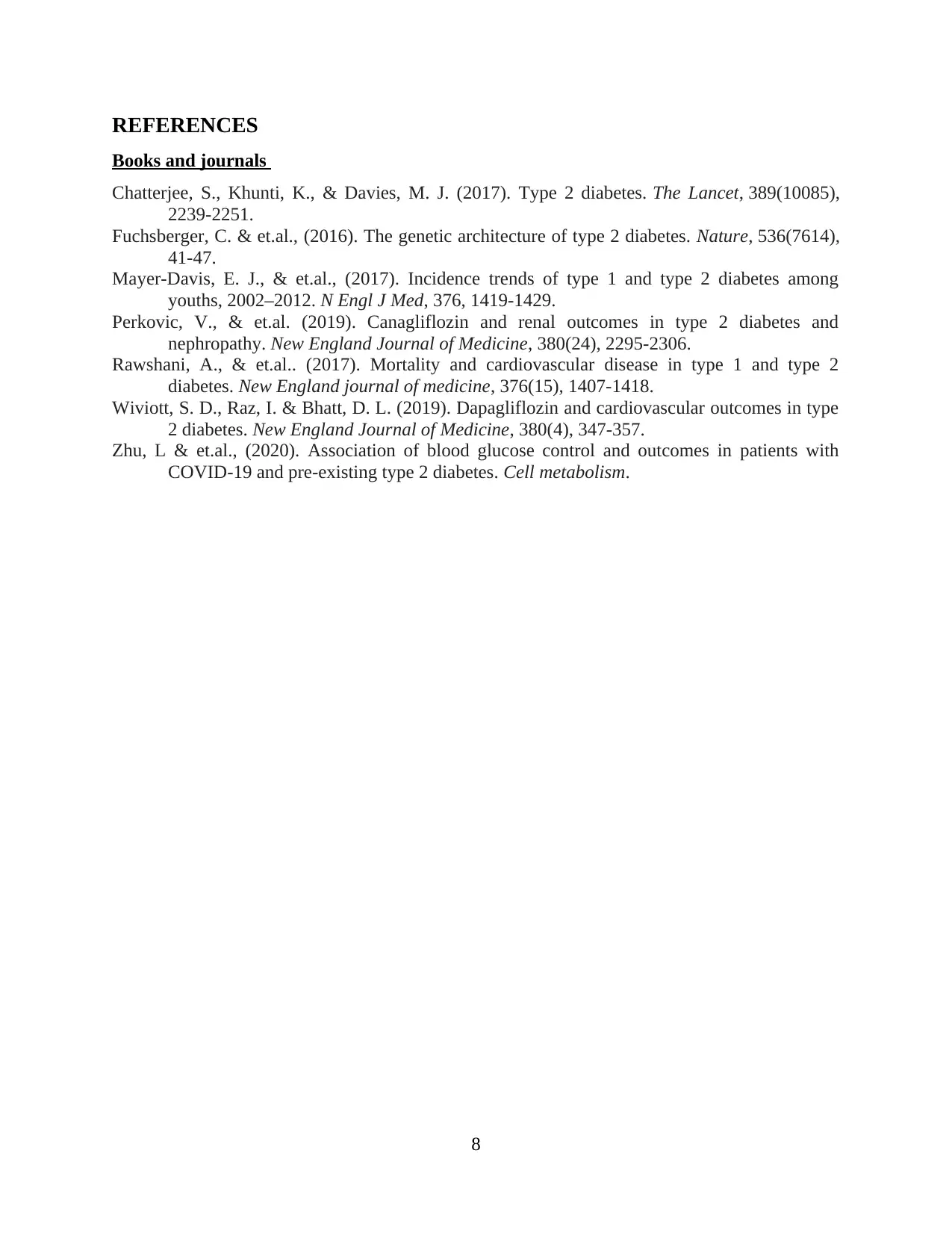
REFERENCES
Books and journals
Chatterjee, S., Khunti, K., & Davies, M. J. (2017). Type 2 diabetes. The Lancet, 389(10085),
2239-2251.
Fuchsberger, C. & et.al., (2016). The genetic architecture of type 2 diabetes. Nature, 536(7614),
41-47.
Mayer-Davis, E. J., & et.al., (2017). Incidence trends of type 1 and type 2 diabetes among
youths, 2002–2012. N Engl J Med, 376, 1419-1429.
Perkovic, V., & et.al. (2019). Canagliflozin and renal outcomes in type 2 diabetes and
nephropathy. New England Journal of Medicine, 380(24), 2295-2306.
Rawshani, A., & et.al.. (2017). Mortality and cardiovascular disease in type 1 and type 2
diabetes. New England journal of medicine, 376(15), 1407-1418.
Wiviott, S. D., Raz, I. & Bhatt, D. L. (2019). Dapagliflozin and cardiovascular outcomes in type
2 diabetes. New England Journal of Medicine, 380(4), 347-357.
Zhu, L & et.al., (2020). Association of blood glucose control and outcomes in patients with
COVID-19 and pre-existing type 2 diabetes. Cell metabolism.
8
Books and journals
Chatterjee, S., Khunti, K., & Davies, M. J. (2017). Type 2 diabetes. The Lancet, 389(10085),
2239-2251.
Fuchsberger, C. & et.al., (2016). The genetic architecture of type 2 diabetes. Nature, 536(7614),
41-47.
Mayer-Davis, E. J., & et.al., (2017). Incidence trends of type 1 and type 2 diabetes among
youths, 2002–2012. N Engl J Med, 376, 1419-1429.
Perkovic, V., & et.al. (2019). Canagliflozin and renal outcomes in type 2 diabetes and
nephropathy. New England Journal of Medicine, 380(24), 2295-2306.
Rawshani, A., & et.al.. (2017). Mortality and cardiovascular disease in type 1 and type 2
diabetes. New England journal of medicine, 376(15), 1407-1418.
Wiviott, S. D., Raz, I. & Bhatt, D. L. (2019). Dapagliflozin and cardiovascular outcomes in type
2 diabetes. New England Journal of Medicine, 380(4), 347-357.
Zhu, L & et.al., (2020). Association of blood glucose control and outcomes in patients with
COVID-19 and pre-existing type 2 diabetes. Cell metabolism.
8
1 out of 8
Related Documents
Your All-in-One AI-Powered Toolkit for Academic Success.
+13062052269
info@desklib.com
Available 24*7 on WhatsApp / Email
![[object Object]](/_next/static/media/star-bottom.7253800d.svg)
Unlock your academic potential
© 2024 | Zucol Services PVT LTD | All rights reserved.





